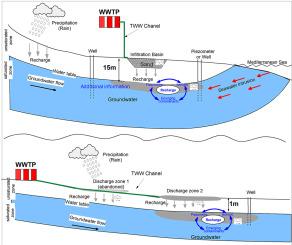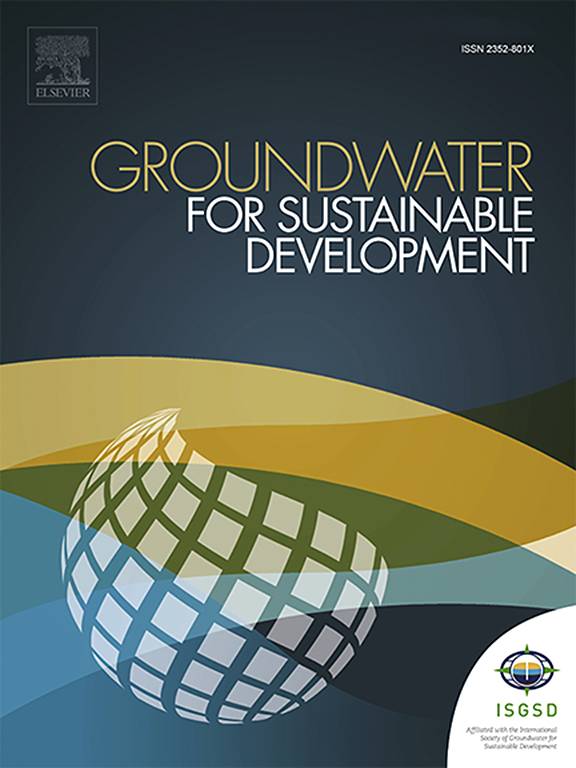结合压力测量法、同位素和新出现的污染物来评估含水层补给作业:Korba和Kairouan站点(突尼斯东北部和中部)的案例研究
IF 4.9
Q2 ENGINEERING, ENVIRONMENTAL
引用次数: 0
摘要
在许多半干旱和地中海地区,稀缺的水资源面临着日益增长的用水需求。一种可能的反应是通过渗透处理过的废水来补充天然地下水补给,但这在数量和质量方面都解决了这种水的未来问题。在突尼斯中部和东北部选择了两个对比鲜明的人工回灌点,处理过的废水。这项研究的重点是实地测量(地下水位、总矿化)和地下水采样(水分子的稳定同位素、新出现的污染物)。2020年的数据与历史记录进行了比较。在第一个地点对137种有机化合物进行了可疑筛选分析。水动力调查和地下水总矿化强调了这两个地点的一个共同特征:水文地质信息的强烈异质性,特别是受到农业抽水的干扰。由于抽水强度大,回灌量较小,地下水人工回灌的正压效应不明显。在这两个地点都观察到地下水盐度略有增加。在科尔巴沿海地区,同位素数据表明,与沿海含水层的其他部分相比,补给区对海水入侵的脆弱性较小。稳定同位素分析表明,只有在水被长距离转移并扩散到地表的地方才有蒸发水。新出现的化合物,特别是卡马西平,提供了一个更精细的充电羽流定义。可疑筛查和非靶点分析结果与该站点的历史位置和第一个站点的排放点搬迁一致。总之,这些结果强调了经典水文地质工具(水动力学、主要离子、稳定同位素)的局限性,以及将新兴化合物整合到分析中的重要附加价值。本文章由计算机程序翻译,如有差异,请以英文原文为准。

Combining piezometry, isotopes, and emerging contaminants to assess aquifer recharge operations: case studies of Korba and Kairouan sites (Northeast and Central Tunisia)
In many semi-arid and Mediterranean regions, scarce water resources face an ever-increasing demand for water. A possible response is to complement the natural groundwater recharge by infiltrating treated wastewater, but this addresses the question of the future of this water, in quantitative and qualitative terms. Two contrasting artificial recharge sites with treated wastewater were chosen at the centre and northeast of Tunisia. The study was focused on field measurements (water table level, total mineralisation) and groundwater sampling (stable isotopes of the water molecule, emerging contaminants). Data from 2020 were compared with historical records. A suspect-screening analysis of 137 organic compounds was also performed at the first site. The hydrodynamic survey and the total mineralisation of groundwater underline a common feature of the two sites: the strong heterogeneity of the hydrogeological information, especially disturbed by agricultural pumping. The positive piezometric effect of groundwater artificial recharge is not clearly, observed due to the combined effects of intense pumping and the relatively small recharge volume. A slight increase in groundwater salinity is observed at both sites. In the coastal area of Korba, the isotopic data show that the recharged area is less vulnerable to seawater intrusion compared to other parts of the coastal aquifer. Stable isotope analysis showed an evaporative water only at the site where the water is transferred over a long distance and spread over the ground surface. Emerging compounds, especially carbamazepine, provided a much finer definition of the recharge plumes. The results of the suspect screening and non-target analysis were consistent with the historical location of the sites and the relocation of the discharge point for the first site. Together, the results underlined the limitation of the classical tools of hydrogeology (hydrodynamics, major ions, stable isotopes) and the significant added value of integrating emerging compounds in the analysis.
求助全文
通过发布文献求助,成功后即可免费获取论文全文。
去求助
来源期刊

Groundwater for Sustainable Development
Social Sciences-Geography, Planning and Development
CiteScore
11.50
自引率
10.20%
发文量
152
期刊介绍:
Groundwater for Sustainable Development is directed to different stakeholders and professionals, including government and non-governmental organizations, international funding agencies, universities, public water institutions, public health and other public/private sector professionals, and other relevant institutions. It is aimed at professionals, academics and students in the fields of disciplines such as: groundwater and its connection to surface hydrology and environment, soil sciences, engineering, ecology, microbiology, atmospheric sciences, analytical chemistry, hydro-engineering, water technology, environmental ethics, economics, public health, policy, as well as social sciences, legal disciplines, or any other area connected with water issues. The objectives of this journal are to facilitate: • The improvement of effective and sustainable management of water resources across the globe. • The improvement of human access to groundwater resources in adequate quantity and good quality. • The meeting of the increasing demand for drinking and irrigation water needed for food security to contribute to a social and economically sound human development. • The creation of a global inter- and multidisciplinary platform and forum to improve our understanding of groundwater resources and to advocate their effective and sustainable management and protection against contamination. • Interdisciplinary information exchange and to stimulate scientific research in the fields of groundwater related sciences and social and health sciences required to achieve the United Nations Millennium Development Goals for sustainable development.
 求助内容:
求助内容: 应助结果提醒方式:
应助结果提醒方式:


